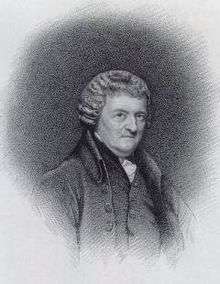Alexander Cumming
| Alexander Cumming | |
|---|---|
 | |
| Born |
1731/2 Edinburgh, Scotland |
| Died |
8 March 1814 (aged 82) Pentonville, England |
| Known for |
Watchmaker Clockmaker Design of the flush toilet Church organ designer Inventor of the first accurate Barograph Inventor of the Microtome |
Alexander Cumming (sometimes referred to as Alexander Cummings) FRSE (1733 –8 March 1814)[1] was a Scottish watchmaker and instrument inventor, who was the first to patent a design of the flush toilet, that had been invented by Sir John Harrington, The S-shaped trap (or bend) was invented by Cumming in 1775 to retain water permanently within the bowl, thus preventing sewer gases from entering buildings.[2] It survives in today's plumbing modified as a U- or J-shaped pipe trap located below or within a plumbing fixture.
Early ife
Cumming was a mathematician and mechanic as well as a watchmaker. Little is known of his early life. He was born in Edinburgh in 1733,[3] the son of James Cumming of Duthil.[4] He is recorded as having been apprenticed to an Edinburgh watchmaker.[1]
Career
In the 1750s he was employed by Archibald Campbell, 3rd Duke of Argyll at Inverary as an organ builder as well as a clockmaker.[5] After his move to England he continued to work in both fields. The Earl of Bute and his family commissioned a series of elaborate barrel organs with which Cumming was involved.[6][7]
By 1763 he had premises in Bond Street, London, and "had acquired a sufficient reputation to be appointed a member of the commission set up in that year to adjudicate on John Harrison's ‘timekeeper for discovering the longitude at sea’".[5] He made a barometrical clock for King George III, who paid him an annual retainer for its maintenance.[8] Other barometrical clocks created by him are at the Science Museum and on the Isle of Bute.[9] He wrote books about watch and clock work, about the effect on roads of carriage wheels with rims of various shapes, and on the influence of gravity.
In 1765 he invented a clock for George III which also acted as a barometer, recording air pressure against time. This is notable as the first accurate recording barograph. In 1766 he made a similar model for his personal use, which on his death was purchased by Luke Howard who used it for his observations within the book The Climate of London.[4]
In 1770 he is credited with the invention of the microtome, a machine for making extremely thin slices as used in slide-preparation, in conjuction with John Hill.[10]
In 1775 he made the major advance on the design of the flushing toilet by adding the concept of water retention within the pan, preventing foul smells from re-entering the house and generally giving a "cleaner" solution.[11]
With his brother he was involved in the development of the Pentonville district of London, where there is a Cumming street. He had a house in the district and an organ shop.
In 1783 he was a joint founder of the Royal Society of Edinburgh and Cumming was made a Fellow.[5][12]
In 1788 Cumming is recorded as a watch and clock-maker on Bond street in London, responsible for the design and manufacture of a church organ for the Church of the Holy Trinity in Christchurch, Cambridgeshire, having earlier created a "self-acting mechanism" already used for an organ for the Earl of Bute in 1787. In 1814 his final patent appears to be for "antisymmetrical bellows" for organ-use.[13]
Death
He died on 8 March 1814., in Pentonville, England.
Publications
- Elements of Clock and Watch Work Adapted to Practice (1766)
Honours
He became a magistrate in 1779. In 1781 he was made an honorary freeman of the Clockmakers' Company.
As a result of his making instruments for Capt. Phipps's voyage in the polar regions, the island of Cummingøya in Svalbard was named after him.[14]
References
- 1 2 https://www.royalsoced.org.uk/cms/files/fellows/biographical_index/fells_indexp1.pdf
- ↑ "The Development of the Flushing Toilet – Detailed Chronology 1596 onwards". Stoke-on-Trent, UK: Twyfords Bathrooms. Retrieved 2015-05-25.
- ↑ http://historyofscience2009.blogspot.co.uk/2009/02/alexander-cummings-c-1775.html
- 1 2 http://www.aim25.ac.uk/cgi-bin/vcdf/detail?coll_id=12097&inst_id=18&nv1=search&nv2=
- 1 2 3 Gloria Clifton (2004), "Cumming, Alexander (1731/2–1814)", Oxford Dictionary of National Biography, Oxford University Press. (Subscription or UK public library membership required)
- ↑ Malloch (1983). "The Earl of Bute's Machine Organ: A Touchstone of Taste". Early Music Vol. 11, No. 2. OUP. JSTOR 3137830. Accessed via JSTOR (subscription required)
- ↑ Lowther Castle National Pipe Organ Register
- ↑ Barometrical Clock by Alexander Cumming at the Royal Collection.
- ↑ Bute Collection; Decorative Arts; Mount Stuart online;
- ↑ http://microscopist.net/Cumming_Hill.html
- ↑ http://historyofscience2014.blogspot.co.uk/2014/02/alexander-cummings-and-flush-toilet.html
- ↑ Cumming, Alexander (1731/2-1814). Royal Society
- ↑ Organs Brittanica: Organs in Great Britain 1660-1860 by James Boeringer
- ↑ Cumming; Polar; [Norwegian];
| Wikisource has original text related to this article: |